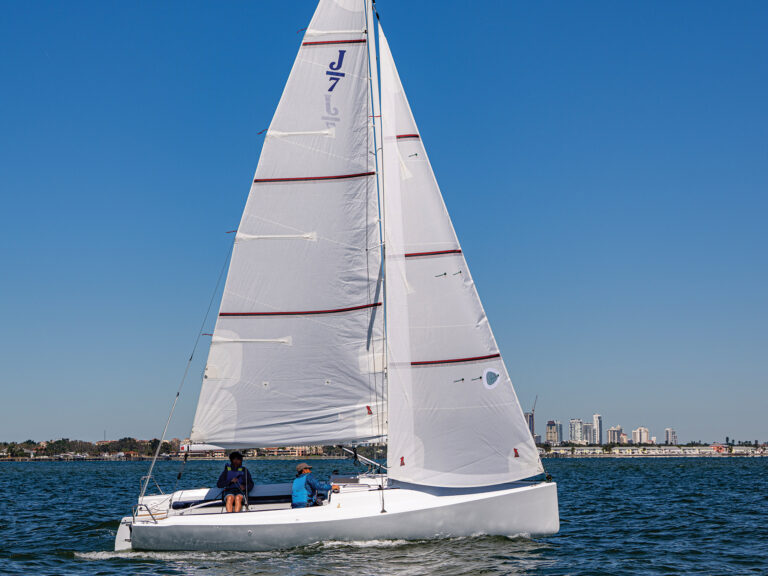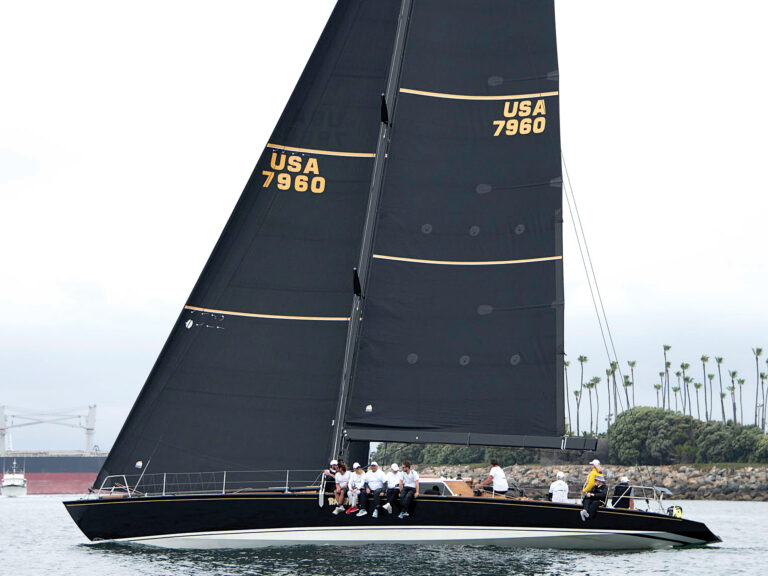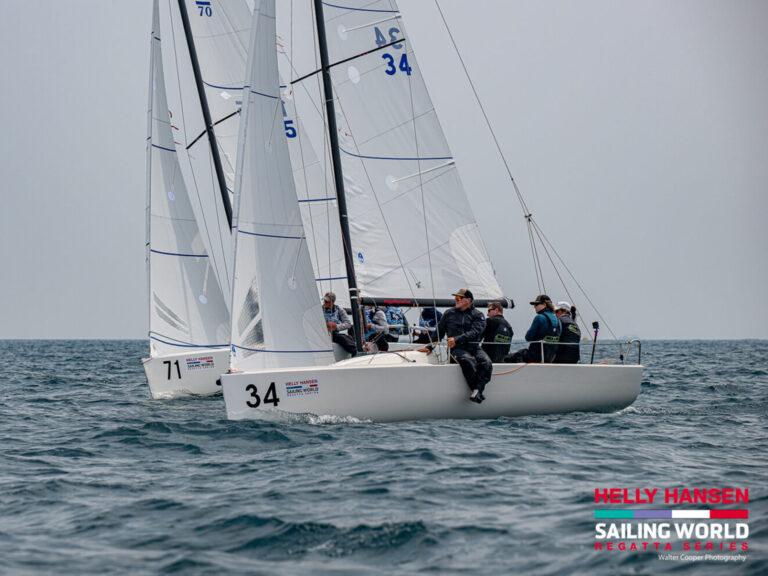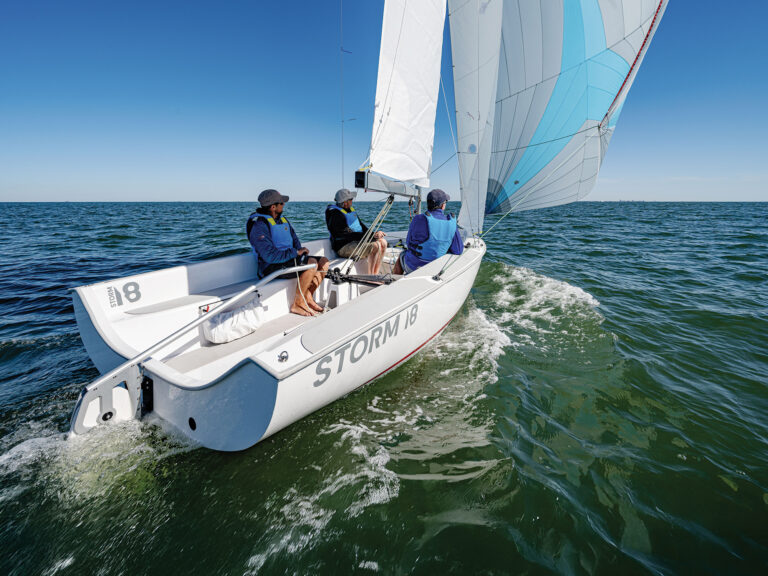
I lay my head back until the lukewarm waters of North Carolina’s Pamlico Sound remove all the strain from my neck muscles. My ears dip below the surface, blocking all sound but the beating of my heart. I squint at the higher power floating above me in the clear blue sky and, silently, offer up a deal: “I’m ready for this to work. I’ll put everything I have into it. But I’ve swallowed as much seawater as I can handle, and my arms are turning to overcooked linguine. I’m going to need some help.”
I raise my head slightly to clear my ears. In place of any kind of response, I get a prompt from Jon, my guide on this journey, who hovers nearby on a Jet Ski. “Send when ready,” he adds, as if it’s no more difficult than dropping a postcard into the mailbox.
After two deep breaths, I gently — tentatively — tug on the right side of a 30-inch bar that is connected by four lines to a 6-square-meter inflatable kite. Immediately, the kite swoops to the right. I respond with a tug on the left side of the bar, sending the kite skying toward the 12 o’clock position.
The lift generated by this first loop pulls me clear of the water, leaving me momentarily standing on a small surfboard. I’ve been here before, a dozen times, maybe more. The first few tries felt like progress. But lately these momentary gravitational vacations have felt more akin to Wile E. Coyote running off a cliff and then hovering long enough to look down, shrug and wave to the camera before plummeting to earth. It’s the second loop — the one that will start me moving — that has given me fits. Too small a bite, and I simply sink back into the water. Too big, and I’m flung through the air like a bug clinging to the end of a whip. I’m not optimistic that this attempt will end any better. But there’s no time to waste. I tug on the right side of the bar, then on the left. And I pray. Again.
A quarter of a century ago, my parents gave me a windsurfer as a high school graduation present. That summer I took to the waters of Narragansett Bay convinced that by Labor Day I’d have mastered the essentials of the sport — the water start, the planing jibe, the chop hop — and that by the following summer I’d be ready for a pilgrimage to Oregon’s Columbia River Gorge.
It was more than a decade, however, before I became even halfway competent on a shortboard. I made my first trip to the Gorge in 1997, but came home humbled and sore. The high point of my second visit, a few years later, was a solitary round trip from the beach to the middle of the channel and back. I did eventually master the basics of a shortboard, but it felt more like an overdue master’s thesis than an athletic milestone. The one thing that held me back the most was my firm belief that I could figure it out on my own. Trial and error may be a cornerstone of scientific discovery, but it’s a lousy way to learn to windsurf.
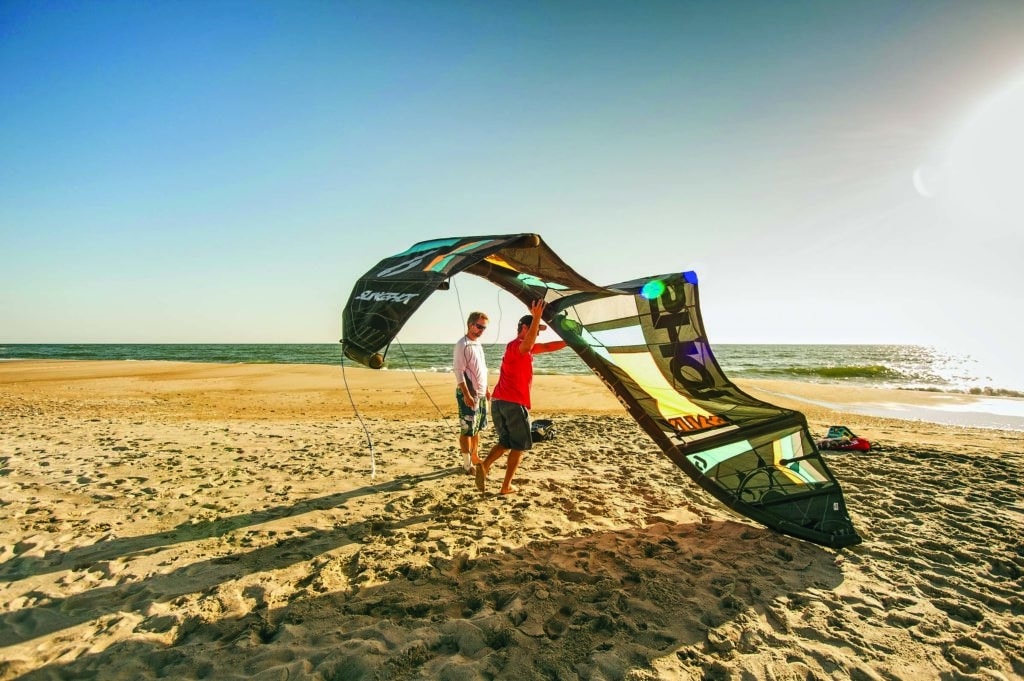
When I was offered the opportunity to learn to kiteboard at Real Kiteboarding, located just north of Cape Hatteras, North Carolina, I saw an opportunity to correctly learn the sport that many see as windsurfing’s successor — and to do so without the process consuming a decade and a half of my life. In fact, said co-founder Trip Forman, they needed just three days. For a middle-aged man with a young family, a full-time job and limited vacation, this was almost too good to be true. I bought my airline ticket, made the appropriate arrangements with work and home, and started debating whether Campy Surprise or Smug Satisfaction would be the best facial expression for the photo of my first big air.
In mid-October I flew to Norfolk, Virginia, and then drove two hours to North Carolina’s thin barrier islands. The sun was disappearing into Pamlico Sound as I drove south on Route 12 and crossed Oregon Inlet. It was hard to keep my car on the road. Over-water sunsets are a rarity on the East Coast, but this one put to shame every Pacific sunset I’ve ever seen. A half-hour later, when I pulled into the parking lot for Real Kiteboarding and the adjacent Watermen’s Retreat lodging complex, the colors lingered on the horizon. I dumped my bags in the third-floor condo, marveled once more at the view, and headed across the parking lot to the grill for dinner and a few beers. Bed followed soon after. Jon Beery, my instructor for the Zero to Hero Camp, had scheduled an early start.
Day One begins on an oceanside beach a mile from the shop. It’s mid-October, and the lack of crowds is a sure sign the offseason in Hatteras has begun, though it’s sunny enough and warm enough to be a midsummer day anywhere in New England. After a quick run-through of how to set up a typical kite, Jon breaks out a 3-meter training kite. There are only two inputs: pull right or pull left, but nonetheless I struggle to keep the kite flying. It dances in Jon’s experienced hands, but once he turns over control, it’s only a matter of seconds before I send it plummeting to earth. My windsurfing instincts are hard to shake, and I often find myself working the bar like I’m driving an 18-wheeler. Jon works to get me controlling the kite with two fingers, not two fistfuls of white knuckles. After an hour or so, I start to get the hang of it, making the kite do small circles on each side of the 12 o’clock position. Then I learn to “trace the edge of the wind window” and land the kite softly on the beach. There’s something incredibly, surprisingly satisfying about kite-flying, and I’m more than a little disappointed when Jon pulls the plug and we head back to Real Kiteboarding for lunch. But the progress is intoxicating. Maybe, I wonder as we drive back to the shop, three days is more than enough.
The afternoon is a rude awakening. More than any other sport I’ve tried, kiteboarding combines two distinct skill groups. Flying the kite is one; the other involves controlling the board. I was expecting that the latter would be the easier of the two, given my experience windsurfing and snowboarding, but after a half-dozen failed attempts to water-start a kiteboard being towed by a Jet Ski, I realize I’m sorely mistaken.
“I’ve never seen anyone hang on as long as you do,” Jon says, searching for something positive to say. “You’re almost pulling the Jet Ski under.” I’m more pragmatic, wondering whether Real’s step-by-step plan accommodates the occasional abject failure.

Toward the end of the session, Jon switches me from a kiteboard — which closely resembles a wakeboard — to a short surfboard. It’s just the change I need, and I pop out of the water the next time Jon hits the gas. I get two rides on the surfboard, carving both sides of the wake, and then one on the kiteboard. I hit the beach with the big campy smile and two sore arms. The day ends with another spectacular sunset. It’s easy to see why anyone who enjoys watersports is drawn to the Outer Banks. Over a few pitchers of beer, Real Kiteboarding co-founder Trip Forman gives me the history of his operation. Forman grew up windsurfing, starting in the days of teak booms and 12-foot one-design boards — he has the sinewy arms, broad shoulders and calloused hands to prove it — and then moving to wave riding and the highly technical Formula raceboards. After graduating from Tufts University, where he had a cup of coffee with the nationally ranked sailing team before deciding he preferred windsurfing’s espresso, he took a sales job with North Sails Windsurfing. With his choice of where to live, Forman put down his stakes on the windy Outer Banks of North Carolina. Back then, windsurfing was one of the few occupants of the now-crowded extreme sports arena, and the future seemed bright. But like any good thrill-seeker, Forman kept an eye out for the next rush.
In the United States, the genesis of kiteboarding points most often in the direction of Cory Roeseler, a water skier from the Pacific Northwest. It was Roeseler’s father who got the idea that a kite could tow a water skier. Cory, equipped with equal parts athletic skill and youthful fearlessness, was a willing guinea pig. Viewed through modern eyes, Roeseler’s setup looks positively medieval: a high-aspect nylon kite, a 6-foot aluminum bar, an unwieldy crank to retrieve the kite, and water skis. But it was effective. It wasn’t long before Roeseler was ripping past the windsurfers — Forman included — on the downwind races at the Gorge. He won so regularly that they started scoring him in his own category.
Forman was one of the first people on the East Coast to order a kite. “We got our first kites in the spring of 1998,” he recalls. “It was a big box with three kites, three line sets and no instructions. Amazingly enough, we got the kite up in the air on our first try, used our windsurfing boards, went out and jibed, and came back.”
The first few sessions went well. The fourth was a different story. Forman attempted a downwind run in a classic southwesterly breeze. “Something went wrong with my kite,” he says. “It kept launching and crashing. I had to time a crash to go under the power lines at Kite Point in Cape Hatteras. I was dragged through bushes, under power lines, over the highway, up the dunes. But I didn’t pop the kite, I didn’t get electrocuted, and I didn’t get hit by a car.”
Bruised and scraped, but unbowed, Forman drew on his one-design and big-boat sailing background to find a solution. “I looked at the kite as a spinnaker,” he says, “and said, ‘Let’s just put snap shackles on the end of the bar and stainless rings on the end of the lines.’ Pop one shackle, and the kite would go flat and flag out.”
The following summer, Forman started teaching kiteboarding out of his van. He parted ways with North Sails Windsurfing in 2000 and set up Real Kiteboarding with partner Matt Nuzzo in 2001. It’s been over a decade since Forman went windsurfing. A few years ago, he surreptitiously plastered “Windsurfing Has Been Cancelled” bumper stickers around Hatteras during a wind-whacker rally. It went over about as well as might be expected. Forman may be a pillar of the local business community, but that memory still evokes a chuckle.

In building their kitesurfing business, Forman and Nuzzo looked to avoid some of windsurfing’s key mistakes, prime among them being the sport’s difficulty in turning novices into longtime participants. They also needed to counter kiteboarding’s growing reputation as a dangerous sport to learn. The result was Real Kiteboarding’s Zero to Hero Camp, a structured three-day curriculum that covers the basics of kitesurfing, including safety, equipment knowledge and technique, with one or two students per instructor.
“Prior to that, people would take one lesson in May, one in August and one in October, and they would learn something and then forget it each time,” says Forman. “If they took all that time and put it into one trip, they could get over the hump and be able to get into the gear. We focus on creating a stable foundation so whenever they exit the program, they can go home and keep practicing at that level.”
Hand in hand with the curriculum was a need for the proper venue and for general spreading of the kiteboarding gospel. Nuzzo and Forman started with a small shop just off Route 12. The property had tremendous potential despite its size, with a good bit of Pamlico Sound waterfront and the remnants of an existing micro-marina. But they eventually committed to a massive retail and lesson-center space with a cafe, bar and waterfront deck. The instruction facilities include a wide, flat lawn ideal for setting up kites — a process that needs about 50 feet of runway — and a harbor for Jet Ski storage. A small barrier island a half-mile offshore creates “The Slick,” a flat-water mecca for first-timers and experts alike. A year after opening the store, Forman and Nuzzo doubled down with a four-story building with 14 luxury two- and three-bedroom rental apartments. The accommodations were the final piece of the puzzle, akin to a fine slopeside condo at one of Europe’s upscale ski resorts.
Among the regular visitors to the Watermen’s Retreat are top amateur and professional sailors. “Racing sailors have a huge advantage when it comes to climbing the learning curve,” Forman says. “They already know the nuances of weather forecasts, wind direction and speed, and wind orientation to the coastline, which is vital in picking the right place to ride. It doesn’t mean you can learn on your own. But the skills, the senses that others have to learn are already there.” Forman adds that while windsurfing and sailing have enjoyed something of an either-or relationship, kiting and sailing are more symbiotic. “When I was young, we’d cruise our boat in the summer — Block Island, Nantucket, Martha’s Vineyard — and I remember it often being windy, but we didn’t have the space to bring the windsurfing gear,” he says. “Kiteboarding gear can easily be stored down below or in a locker.”
Day Two starts with an extra dose of ibuprofen. My tenacity the previous day has taken a toll on my arms. But the wind is blowing in the low teens and expected to stay for most of the day — perfect learning conditions. We grab a 12-meter kite and a pair of boards and head out on the water. Jon positions us just off the shoreline of the scrub island that marks the southwest side of The Slick. In waist-deep water, he runs me through the next step of the progression. We work on kite control, keeping the kite directly overhead in the safety position and then working it toward the water to each side. Progress is slow but steady. The inflatable kites are both durable and forgiving, and easy to relaunch after a crash. Once my kite control reaches a reasonable level, we move on to body dragging, which is essential for reuniting with your board after a wipeout. It would certainly be easy to skip steps like this one, but the Zero to Hero program encompasses all the skills necessary to kiteboard, even those that are less than glamorous, such as being dragged through the water like a gill-hooked fish.
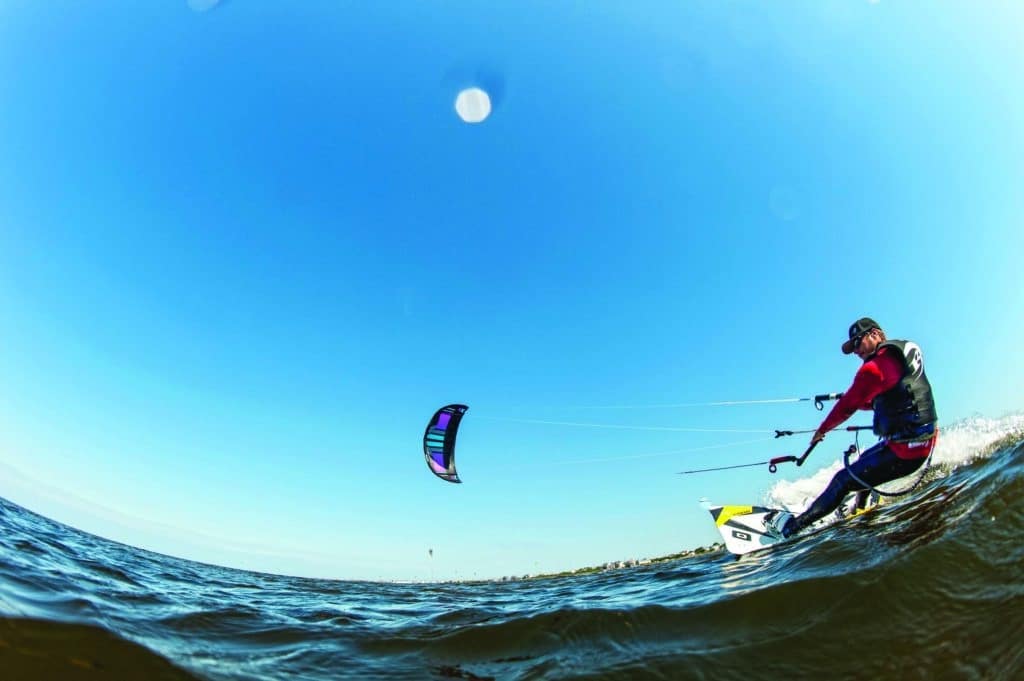
After lunch, it’s time to kiteboard. With a day and a half of training behind me — about three times what it took Jon to get his first ride, I find out later — I’m confident I’ve put in the work. Now it’s time for the payoff, and with a day to spare. As with the previous day, the afternoon is an exercise in humility. The ability to keep the kite hovering in the safety position while I wriggle my feet into the kiteboard straps is elusive, and my efforts are exhausting. Trying to determine exactly how much power to put into the kite is even more challenging. Too small a loop, and I never get clear of the water. Too big a loop, and the kite rips me into the air and whips me back down. I get close a few times, but cry uncle when the fatigue becomes too much. “You’re so close,” Jon says many times that evening. “It’s going to happen. Just you wait.”
The following day there’s no wind, but I’m not complaining. My body could use a day off. We run through the on-land portion of the program, reviewing equipment selection, maintenance and repair. It’s hardly riveting content, but there’s a lot of valuable information. Jon suggests we do some more work off the back of the Jet Ski, but I beg off, hoping to save my arms for one last session the following morning.
A front blows through that evening, and the northwesterly breeze fills in with authority behind it. I sleep fitfully, waking regularly to hear the taunting whistle of the wind through the stainless rigging on the deck. The next morning the wind is still in the mid-20s and showing no signs of dropping. I resign myself to heading home without having fulfilled my mission; I’m certainly not a zero, but I’m still closer to that than the intended goal.
Jon has other plans. It’s windy, he acknowledges, but below their limit for beginning lessons. We grab a small kite and the rest of the gear and head out. The first hour is more of the same. But even as the frustration mounts, I can see signs of progress. My kite control is improving, and it takes less concentration to keep it flying as I struggle to get my board and body aligned for a water start. My crashes are also less dramatic, and the downtime between water-start attempts is getting shorter.
On the negative side, however, I’m tired, I’ve got a plane to catch, and for the first time, Pamlico Sound is full of windsurfers. Knowing I could be ripping across the water like them is a heavy dose of salt on my wounded pride. Why, I ask myself, is this old dog trying to learn new tricks? Jon’s optimism, however, is infectious, and keeps me focused on the task at hand. With time running short, he switches me to the small surfboard, hoping to recreate the same magic from the end of Day One.
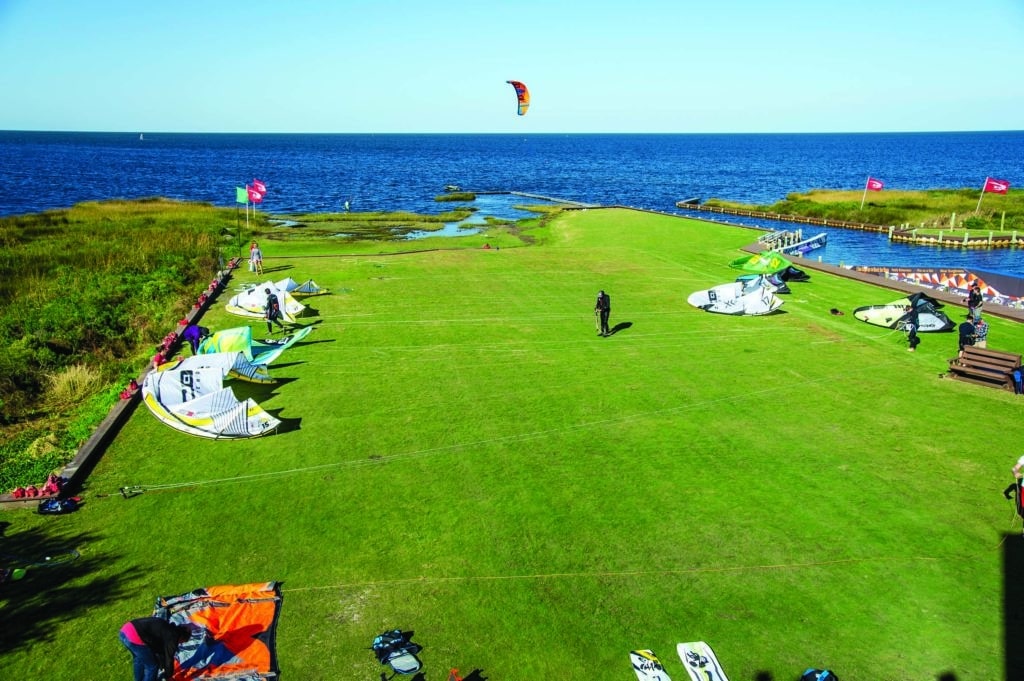
Whether that was the pivotal component, I’m not sure. It might have been a few deep breaths, another jab of positive reinforcement, or simply the culmination of three days of hard work. Or perhaps it was divine intervention. Whatever the case, it works. The first loop pulls me free of the water, and then the second loop generates the right amount of power, and the next thing I know, I’m skimming across the water.
I try to remember all the advice I’ve received over the past two and a half days: loose arms, gentle motions with the bar, let the harness carry the load, absorb the chop with your legs. But mostly, I just enjoy the ride. Even for an experienced windsurfer, it’s a near-religious experience. The speed is effortless. When the kite does what I want, it feels like I’m in complete control of an extremely powerful animal, like taking a tiger out for a gallop around the savanna.
After a few minutes, my foot starts to work free from the straps, so I bring the kite up to 12 o’clock and slowly sink into the water. Jon is at my side a moment later, and we share a happy “told ya so” moment.
I get in a few more rides over the next half-hour before the fatigue again sends me to shore. My Zero to Hero report card is shy of perfect: My rides are exclusively on starboard tack, and I can’t replicate my success going the other direction; I’m also unable to water-start the standard kiteboard. But I’m feeling pretty good nonetheless as I drive north on 12, headed for the airport in Norfolk.
In four days, I accomplished what took me the better part of a decade as a windsurfer. I’m not sure when my next kiteboarding adventure will take place, but there’s a good chance it will happen before I go windsurfing again.
Think you can go from zero to hero? Check in at [www.REALwatersports.com/kiteboarding]





